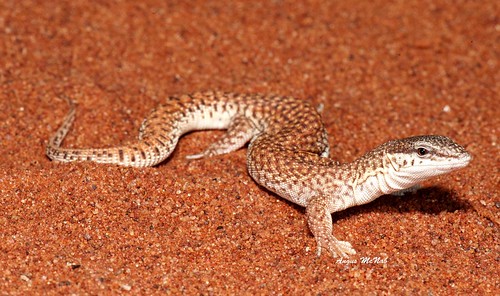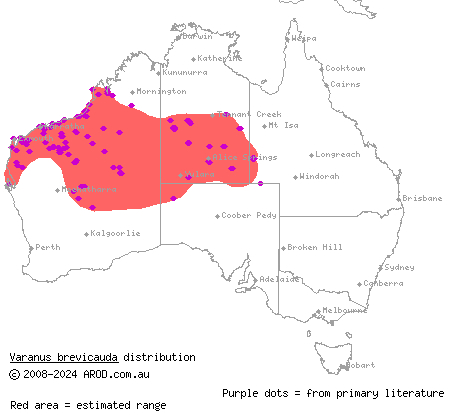Post by creature386 on Sept 1, 2015 18:08:04 GMT 5
Copied from the profile by the member Ceratodromeus (our Ceratodromeus) on carnivora with permission.
Pygmy(short tailed) monitor - Varanus brevicauda

Scientific classification
Kingdom: Animalia
Phylum: Chordata
Subphylum: Vertebrata
Class: Reptilia
Order: Squamata
Suborder: Lacertilia
Family: varanidae
Genus: Varanus
Subgenus: Odataria
Species: V.brevicauda
Description
This species is regarded as the smallest extant member of the Varanids genus. Healthy adults measure anywhere from 70-126mm(2.7-4.9in)in snout-vent length, with most falling in the 80-95mm(3.1-3.7in) range. Tail length makes up an considerable amount of total body length for this species, being anywhere from 80 to 128℅ longer then the animals' snou-vent measurement(tail length can measure 51-89mm, or 2-3.5in){1}. Literature appears to show that the species can grow to approximately 0.25m(9.8in)in total body length{2}. The species is sexually dimorphic, with females attaining slightly larger sizes then conspecific males. This species can be identified by its light tan to dark brown coloration, with small ocellelation patterning running down its enter length. The underside of this lizard is entirely white. A dark stripe can be found running from the snout- to the back of the skull.

Geographic range
This varanid is thought to range throughout most of Eastern Australia. It is a secretive, shy species that prefers sandy areas with large amounts of Spinifex grasses. They have also been documented utilizing burrows{3}.

Dietary habits
Like most members of the Varanus genus, the Pygmy monitor is a dietary generalist. The majority of the prey animals taken are invertebrates; grasshoppers, spiders, cattepillars, and centipedes have all been taken. They are also known to predate on lizards, mainly skinks of the ctenotus genus. Species that have been documented are the blue tailed skink(Ctenotus calurus), and the Pilabra ctenotus(Ctenotus duricola). It has also been documented feeding on reptile eggs{1,3}.
Reproduction
Mating is thought to occur through spring(July-November), with eggs developing through October to December. A typical clutch size is 2 to 3, though larger clutch sizes(4-5)have been reported. When the eggs hatch, they neonates measure 42-45mm(1.6-1.7in)in snout-vent length, and grow quickly within their first year of life{1,4}. Males reach sexual maturity at roughly 70mm(2.7in), while females take longer to mature, at approximately a snout-vent length of 80mm(3.1in){4}.

References
{1}King, Dennis R., and Eric R. Pianka. "Ecology of the Pygmy Monitor Varanus brevicauda in Western Australia." Advances in Monitor Research III.–Mertensiella 6 (2007): 304-3.
{2}Losos, JONATHAN B., and HARRY W. Greene. "Ecological and evolutionary implications of diet in monitor lizards." Biological Journal of the Linnean Society 35.4 (1988): 379-407.
{3}Pianka, ERIC R. "Comparative ecology of Varanus in the Great Victoria desert." Australian Journal of Ecology 19.4 (1994): 395-408.
{4}James, Craig D. "Ecology of the pygmy goanna (Varanus brevicauda) in spinifex grasslands of central Australia." Australian Journal of Zoology 44.2 (1996): 177-192.
Pygmy(short tailed) monitor - Varanus brevicauda

Scientific classification
Kingdom: Animalia
Phylum: Chordata
Subphylum: Vertebrata
Class: Reptilia
Order: Squamata
Suborder: Lacertilia
Family: varanidae
Genus: Varanus
Subgenus: Odataria
Species: V.brevicauda
Description
This species is regarded as the smallest extant member of the Varanids genus. Healthy adults measure anywhere from 70-126mm(2.7-4.9in)in snout-vent length, with most falling in the 80-95mm(3.1-3.7in) range. Tail length makes up an considerable amount of total body length for this species, being anywhere from 80 to 128℅ longer then the animals' snou-vent measurement(tail length can measure 51-89mm, or 2-3.5in){1}. Literature appears to show that the species can grow to approximately 0.25m(9.8in)in total body length{2}. The species is sexually dimorphic, with females attaining slightly larger sizes then conspecific males. This species can be identified by its light tan to dark brown coloration, with small ocellelation patterning running down its enter length. The underside of this lizard is entirely white. A dark stripe can be found running from the snout- to the back of the skull.

Geographic range
This varanid is thought to range throughout most of Eastern Australia. It is a secretive, shy species that prefers sandy areas with large amounts of Spinifex grasses. They have also been documented utilizing burrows{3}.

Dietary habits
Like most members of the Varanus genus, the Pygmy monitor is a dietary generalist. The majority of the prey animals taken are invertebrates; grasshoppers, spiders, cattepillars, and centipedes have all been taken. They are also known to predate on lizards, mainly skinks of the ctenotus genus. Species that have been documented are the blue tailed skink(Ctenotus calurus), and the Pilabra ctenotus(Ctenotus duricola). It has also been documented feeding on reptile eggs{1,3}.
Reproduction
Mating is thought to occur through spring(July-November), with eggs developing through October to December. A typical clutch size is 2 to 3, though larger clutch sizes(4-5)have been reported. When the eggs hatch, they neonates measure 42-45mm(1.6-1.7in)in snout-vent length, and grow quickly within their first year of life{1,4}. Males reach sexual maturity at roughly 70mm(2.7in), while females take longer to mature, at approximately a snout-vent length of 80mm(3.1in){4}.

References
{1}King, Dennis R., and Eric R. Pianka. "Ecology of the Pygmy Monitor Varanus brevicauda in Western Australia." Advances in Monitor Research III.–Mertensiella 6 (2007): 304-3.
{2}Losos, JONATHAN B., and HARRY W. Greene. "Ecological and evolutionary implications of diet in monitor lizards." Biological Journal of the Linnean Society 35.4 (1988): 379-407.
{3}Pianka, ERIC R. "Comparative ecology of Varanus in the Great Victoria desert." Australian Journal of Ecology 19.4 (1994): 395-408.
{4}James, Craig D. "Ecology of the pygmy goanna (Varanus brevicauda) in spinifex grasslands of central Australia." Australian Journal of Zoology 44.2 (1996): 177-192.


